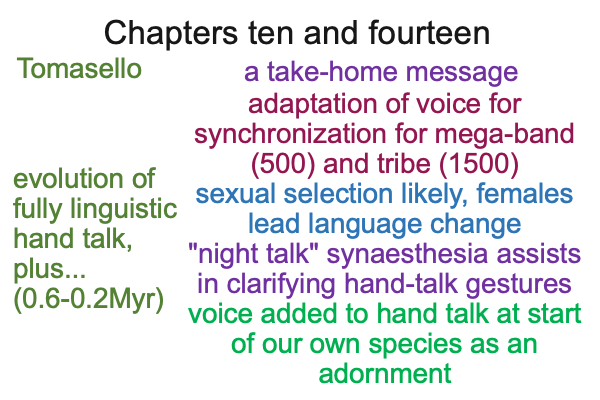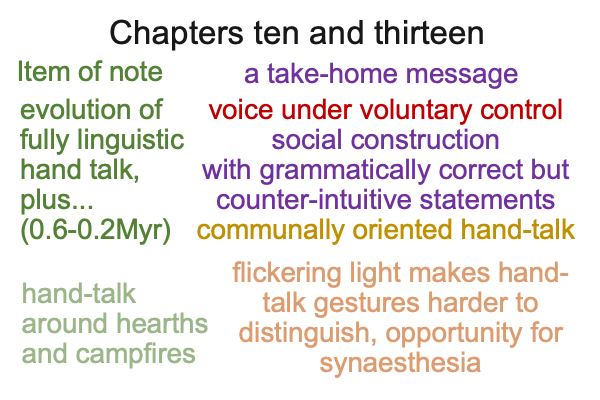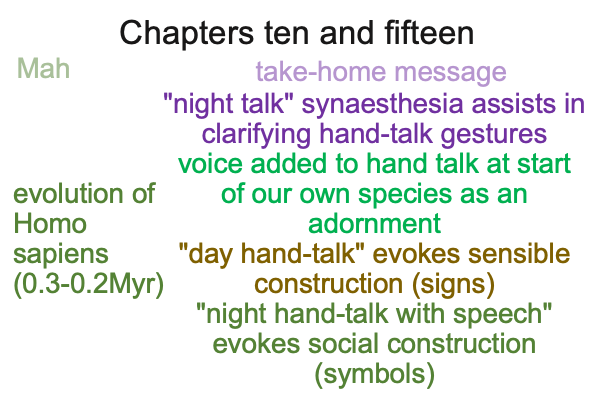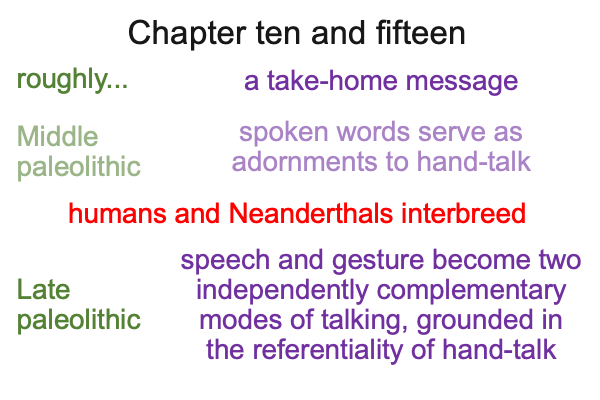How The Voice Gets Added to Hand-Talk In Human Evolution, Part A5 (Part 21 of 23)
0207 Yes, Language, Perception and Thought, is the title of chapter fourteen.
The following is what this examiner sees implicit within Mithen’s text, while the text itself explicitly arranges the same information according to an entirely different narrative.
The following seems like an imposition. But, it conforms to the tenor of chapter fourteen.
After the domestication of fire, hand-talk fundamentally changes, along with hominin perceptions and thought. This change sets the stage for the question that Mithen implicitly addresses, asking, “How does the voice get added to hand talk in human evolution?”

0208 The basis for Mithen’s explicit arrangement, the critical assumption, is found in chapter four. The author rules out consideration of the gestural origins of language.
0209 The basis for the implicit scenario is found in an independent approach, allowing consideration of the gestural origins of “language”, as defined by two characteristics, displacement and symbolic operations. Clues that substantiate the implicit scenario run through Mithen’s text, starting with the identification of the two defining characteristics, displacement and grammar.
One important clue is Mithen’s hypothesis of synaesthesia as the basis for the co-evolution of speech and displacement. Synaesthesia happens when sensations cross modes. For example, something visible cross modes to yield something acoustic. Image gets confounded with sound. In this manner, fully linguistic hand-talk is adorned with voluntary utterances.
0210 Another important clue is Mithen’s elevation of fire as a situation in which synaesthesia manifests. Fossils of Homo heidelbergensis appear along with evidence for the domestication of fire. Mithen presents the dots, but does connect them in a way that reveals how synaesthesia is crucially important.
The metaphor of the jigsaw puzzle is another clue. When the metaphor is taken literally, when a word is like a piece of a jigsaw puzzle, a picture emerges for how hand-talk gesture-words display displacement and provide the raw material for a symbolic order.
0211 I now attend to a different list of take-home messages for chapters ten and fourteen. The third lesson in the list reflects Mithen’s hidden hypothesis.

0212 To start, after the domestication of fire, hand-talk becomes fully linguistic. The foundational requirements are already established in proto-linguistic hand talk. A key development (and it is substantial) is that fully linguistic hand-talk permits grammatically correct counter-intuitive statements that defy sensible construction. Social construction is required.
0213 The Neanderthal and human lineages separate around 600kyr (thousands of years ago), long before this process is complete. Neanderthal retains hand-talk in sensible constructions.
0214 With respect to our own lineage, natural (and cultural) selection operates on the social circle of the community (150). The community (150) has higher number resonances, following Dunbar’s rule of three. The mega-band (500) gathers seasonally. The tribe (1500) gathers occasionally. The voice is recruited for synchronization (communal singing).
With this type of general selection, sexual selection follows.
0215 Once the voice is under voluntary control, then Mithen’s intuition about the crucial role of synaesthesia in language evolution comes into play, in a way that the author does not explicitly envision. Night-talk already involves singing and dance. Hand-talk stories are told before the campfire, like the one where the fellow hit the vulture instead of the jaguar in the tree. These stories trigger social construction of perspective-level cognitive spaces. Each cognitive space serves as a way to actualize the community as the team of teams.
0216 One problem with this night-talk is that manual-brachial word-gestures are more difficult to recognize. So, members of the team of teams act out a solution, by attaching a (purely-symbolic) vocalization to each word-gesture. Mithen discusses the idea in chapter six, concerning iconic and arbitrary words. Visual sensations from hand-talk spill into acoustic adornments. In the process, the voice is added to hand talk, as an adaptation to night-talk.





